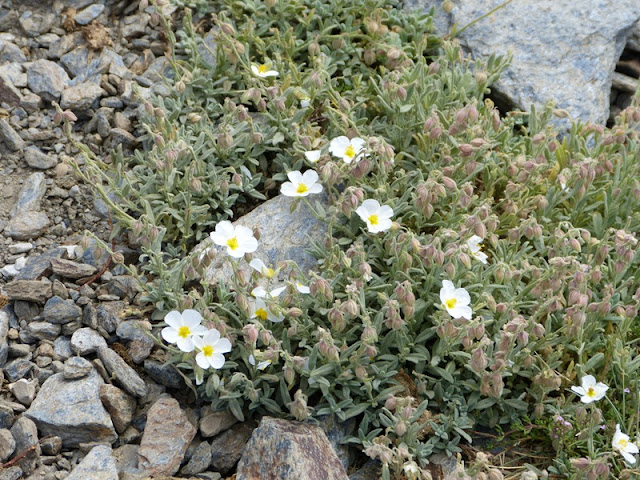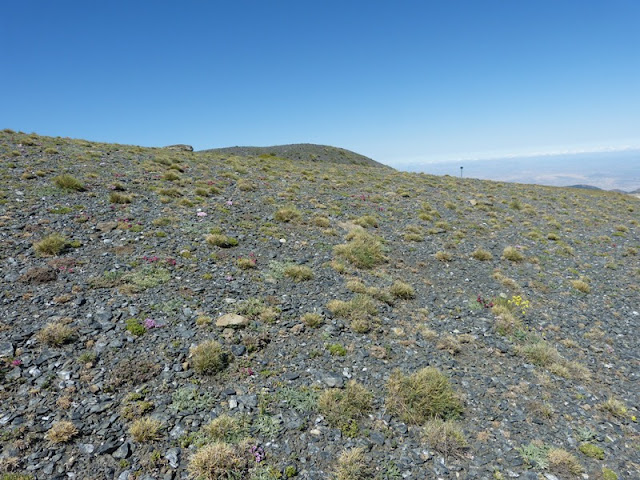I remember back in 2014 before I went to the Sierra Nevada I asked for information about good walks there where I would be able to see butterflies. I was surprised when the recommended walk was up at the Hoya de la Mora carpark, which is over 2,500 metres up in the mountains.
I was told it was a great place to find Zullich’s Blues, Sierra Nevada Blues, Spanish Brassy Ringlets and various other endemic or rare species. A look at Google aerial views showed a very baron, rocky environment. I was particularly surprised that I was also told that July was the perfect time of year to see butterflies, thinking that it would be particularly hot and dry then.
What I didn’t take account of was altitude. What I discovered when I visited was that at 9am it was only 10 degrees Celsius at Hoya de la Mora, rising to 17 degrees by midday. Only 15 kilometres away in Granada the temperature was over 35 degrees.
Hoya de la Mora is a popular ski resort and for seven months in the year is covered in snow. Even in July there are odd pockets of snow in shady spots.
All of this makes the high Sierra Nevada mountains a unique habitat supporting a very interesting variety of flora. It wasn’t until I started walking that I notice all of the small plants tucked into cracks in the rocks. Here are a few examples that I have tried to name, although I am no expert.
I was very intrigued to see what looked like Kidney Vetch, Anthyllis vulneraria, but instead of the yellow-flowered plant I am used to seeing on the east coast of Scotland, in the Sierra Nevada it is pink. I think this is the subspecies arundana, although there are other pink subspecies found in mountain ranges across Europe.
The plant below is a Cerastium species. There are many very similar species. An endemic of the Sierra Nevada is Cerastium alpinum ssp. nevadan, but I can't be sure that this is what this one is.
I am a great fan of Dianthus, so I was delighted to see this one dotted around the rocks there. I think it is Dianthus brachyanthus, although there seem to be many different names given for species and sub-species depending on which book or website you look at!
This is Erodium cheilanthifolium, which is found on many mountain ranges in Spain.
There was a lovely white Rockrose growing amongst the rocks and scree. I think this is Helianthemum apenninum, which is said to occur in the Sierra Nevada, although there is another very similar-looking Helianthemum almeriense that occurs in southern Spain.
In these same areas I have seen this lovely little pink flower, Nevadensia purpurea. It forms lovely cushions, covered in flowers and only occurs in the Sierra Nevada.
Another lovely little prostrate flower found high in the Sierra Nevada is Leontodon boryi, which also appears to be endemic to the Sierra Nevada.
Jurinea humilis gave a lovely splash of colour on some of the exposed slopes. It is found over much of Spain above 1500 metres.
There were so many other flower amongst the rocks and scree and I mostly photographed those that were in flower. I believed that over 2100 different species of plants have been recorded in the Sierra Nevada, so what I saw was only a fraction of those. Just a few more!!
The Sierra Nevada Violet, Viola crassiuscula, seemed to be quite common along the side of the paths that I walked on. Yet again, this plant is endemic to the Sierra Nevada.
I particularly liked the Sempervivum vicentei, which squeezed into small cracks in the rocks.
I was intrigued by this woody plant that I spotted between two large rocks at the bottom of a scree slope. It is Prunus prostrata, a little cherry tree!
This prostrate Juniper, Juniperus sabina, was quite common in some areas. It gave off a lovely scent when I brushed against it trying to get pictures of butterflies!!
Not all of the area up there was so bare and rocky. Next to a stream and in damper areas below springs there were green areas of grass with wild flowers.
So many of these species are only found on the Sierra Nevada mountains and they are quite vulnerable to erosion. I noticed this summer when I was there that the National Park have blocked off some of the paths and are encouraging walkers to stick to the main paths. They are also preventing cyclists using the rough paths, asking them to stick to the road, to try to reduce erosion of the mountainside.
I was always very conscious not to stand on any plants and often I felt as though I was in the middle of an amazing rock garden!
Further down the mountains by about 1500 metres above sea level there were a lot more shrubs and trees and the flowers there are taller and very similar to what can be found in other areas of meadow in Spain.






















Very enjoyable blog-loved seeing all these beautiful alpines. When I saw the photo of Erodium cheilanthifolium I thought it looked very similar to E. petraeum I saw in the rock garden at Kew a couple of days back. Looking in the Alpine Garden Society site they appear to be synonyms-no wonder I thought it looked so similar!
ReplyDeleteThank you Conehead! I must have a look at the Alpine Garden Society web site. I had trouble identifying many of these plants as it appears that a number of them are known by different names, some are considered true species and other sub-species.
DeleteHello Nick :=)
ReplyDeleteWOW! A veritable garden of low growing plants I'm so glad you shared these pretty flowers, and now understand why so many butterflies can be found in the Siera Nevada.
Nick, you asked about the Two-tailed Pasha. I have never seen one, but I believe that they can be seen in the south of Portugal .
It really is a special place, Sonjia. Although I really go there for the butterflies it is always a thrill to see the amazing wild flowers in the high Sierra Nevada.
DeleteIf things in Portugal go the same was as here in Scotland then butterfly species will be expanding their range northwards and you may see Two-tailed Pasha there soon!